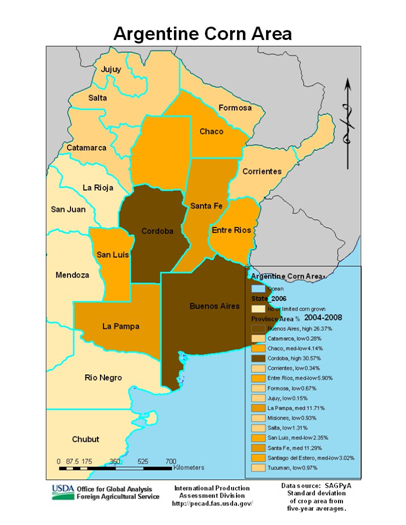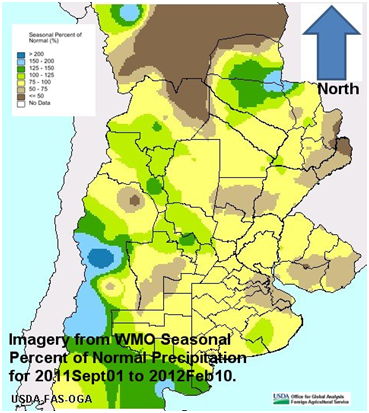Early Planted Argentine Corn Suffered from Hot Weather and Limited Rains
Argentina usually supplies about 25 percent of corn from the big southern hemisphere corn exporters (Brazil, Argentina and South Africa) but very hot weather and scant rains at the end of November through mid-January has increased concern about the crop. The USDA estimates 2011/12 Argentine corn production at 22 million tons, down 15 percent from the January estimate. The reduction was due to early planted corn suffering from drought damage during pollination.

In Cordoba, Argentina’s second largest corn and soybean producing province, a drought emergency was declared on Tuesday, January 17, 2012. A handful of other districts in surrounding provinces also made the declaration. The emergency measure for Cordoba will be in force until March 19, 2013 to helped affected farmers and ranchers in the region through the Federal Administration of Public Revenue.
The Argentine Minister of Agriculture, Norberto Yauhar, met in late January with rural leaders from Cordoba as well as from the provinces of Buenos Aires, La Pampa, Neuquén and San Juan to discuss needs in the countryside due to the agricultural emergency from the drought.
End of November through mid-January weather was hot and had limited rain. No substantial rain occurred across the Argentine corn grain belt until January 13, 2012. With that rain, maximum temperatures have largely moderated to 80oF to 90oF (27oC to 32oC) from earlier weather, when some highs reached over 100oF (38oC) in December and early January.
The next shot of rain then occurred on January 15 when a cold front brought showers and storms with cooler weather. Continued rains have helped many areas, although sporadic in spots. Rains into the second week of February have further helped ground moisture supplies for later planted corn. Early planted corn, however, did not receive rain soon enough to prevent severe damage in many fields in the core corn region of Argentina.

Rains have continued to not be consistent or evenly distributed. Fields reveal quite variable crop conditions. Different soils which have different moisture-holding capacities as well as very variable rainfall conditions, have made it difficult to determine crop conditions.
In their January 18 monthly report, the Argentine Ministry of Agriculture estimated that it was possible to have lost 20 to 50 percent of the planted area of corn. Only about one percent of observed fields were listed in very good condition. About 32 percent of viewed fields were in good condition, 42 percent were normal and 25 percent were reported as bad. In the February 9 report from the Ministry, accumulated rain continues to be quite variable across regions.
A question that the Minsitry is trying to answer is: how much of the early corn crop will have low yields and how much was cut for forage or grazed. Last year, consistent showers helped stabilize corn yields.
The Argentine Ministry of Agriculture continues to list planted area for corn (for grain and forage) without an estimate on losses. The February 9 Ministry report had planted corn at 4.92 million hectares (ha). Bolsa Cereales in Buenos Aires forecasts a much lower planted corn area at 3.66 million ha of corn for grain.
The USDA agricultural attaché traveled in mid-January through the northwest sector of Buenos Aires province to southwest Cordoba province and into the southwestern tip of Santa Fe province to assess the drought situation. Many corn fields have been cut for silage or had cattle turned out to graze. Some corn did not develop ears in the sandier, drought-prone fields. Chivilcoy in Buenos Aires and Laboulaye in Cordoba have tasseled corn on smaller than normal plants, some less than 2 meters. Corn in Pehuajo and Lincoln in the province of Buenos Aries were also not as tall as during years with more rainfall, but are not showing extensive drought stress. Late-planted-corn across the core area viewed looks fairly good. It is the early planted corn which suffered high temperatures and moisture deficits during pollination that will have much lower yield.
The next WASDE (World Agricultural Supply and Demand Estimates) report from USDA will be released March 9, 2012 at 8:30 AM online at http://www.usda.gov/oce/commodity/wasde/. (For additional information, contact Dr. Denise McWilliams, 202-270-0107.)
Current USDA area and production estimates for grains and other agricultural commodities are available on IPAD's Agricultural Production page or at PSD Online.
Visit Crop Explorer http://www.pecad.fas.usda.gov
|

